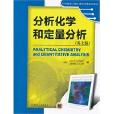《分析化學和定量分析(英文版)》是2012年1月1日機械工業出版社出版的圖書,作者是[美] 哈格(David S.Hage)、[美] 卡爾(James D.Carr)。該書主要闡述了定量分析化學、分析實驗室及分析研究的科學理論的概念。
基本介紹
- 書名:分析化學和定量分析(英文版)
- 作者:[美] 哈格(David S.Hage)、[美] 卡爾(James D.Carr)
- 出版社:機械工業出版社
- 出版時間:2012年1月1日
- ISBN:9787111367260
內容簡介,目錄,
內容簡介
《時代教育·國外高校優秀教材精選:分析化學和定量分析(英文版)》內容包括:分析化學縱覽,好的實驗室實踐,質量和體積的測量,根據數據作決定,分析方法的特[生描述和選擇,化學活性和化學平衡,化學溶解性和沉澱物,酸鹼反應,絡合物形成法,氧化反應,重量分析,酸鹼滴定法,絡合物滴定法和沉澱滴定法,電氣化學分析簡介,氧化還原滴定法,庫侖法、伏安法和相關方法,光譜分析法概論,分子光譜,原子光譜,化學分離簡介,氣相色譜法,液相色譜法,電泳。《時代教育·國外高校優秀教材精選:分析化學和定量分析(英文版)》適合作為化學化工類專業,醫藥、生物、食品等專業的教材。
目錄
Chapter 1 An Overview of Analytical Chemistry
1.1 Introduction: The Case of the Mysterious Chemist
1.2 The History of Chemical Analysis
1.2 A Origins of Chemical Analysis
1.2 B Chemical Analysis in the Modern World
1.3 General Terms Used in Chemical Analysis
1.3 A Sample-Related Terms
1.3 B Method-Related Terms
1.4 Information Provided by Chemical Analysis
1.5 Overview of Text
Key Words
Other Terrns
Questions
References
Chapter 2 Good Laboratory Practices
2.1 Introduction: A Question of Quality
2.1 A What Are Good Laboratory Practices?
2.1 B Establishing Good Laboratory Practices
BOX 2.1 : The Polymerase Chain Reaction
2.2 Laboratory Safety
2.2 A Common Components of Laboratory Safety
2.2 B Identifying Chemical Hazards
BOX 2.2 : Detemining the Safety of Chemicals
2.2 C Sources of Information on Chemicals
2.2 D Proper Handling of Chemicals
2.3 The Laboratory Notebook
2.3 A Recommended Notebook Practices
2.3 B Electronic Notebooks and Spreadsheets
2.4 Reporting Experimental Data
2.4 A The SI System of Measurements
2.4 B Significant Figures
Key Words 31
Other Terms 31
Questions
References
Chapter 3 Mass and Volume Measurements
3.1 Introduction: J. J. Berzelius
3.2 Mass Measurements
3.2 A The Determination of Mass
3.2 B Types of Laboratory Balances
BOX 3.1 : Atomic Force Microscopy
3.2 C Recommended Procedures for Mass Measurements
3.3 Volume Measurements
3.3 A The Determination of Volume
3.3 B Types of Volumetric Equipment
3.3 C Recommended Procedures for Volume Measurements
3.4 Samples, Reagents, and Solutions
3.4 A Describing Sample and Reagent Composition
3.4 B Solution Preparation
Key Words 58
Other Terms
References
Chapter 4 Making Decisions with Data
4.1 Introduction: Take Me Out to the Ball Game?
4.1 A Types of Laboratory Errors
4.1 B Accuracy and Precision
4.2 Describing Experimental Results
4.2 A Determining the Most Representative Value
4.2 B Reporting the Variation in a Group of Results
4.3 The Propagation of Errors
4.3 A Addition and Subtraction
4.3 B Multiplication and Division
4.3 C Logarithms, Antilogarithms, and Exponents
4.3 D Mixed Calculations
4.4 Sample Distributions and Confidence Intervals
4.4 A Describing the Variation in Large Data Sets
4.4 B Describing the Variation in Small Data Sets
BOX4.1 Who Was "Student"?
4.5 Comparing Experimental Results
4.5 A General Requirements for the Comparison of Data
4.5 B Comparing an Experimental Result with a Reference Value
4.5 C Comparing Two or More Experimental Results
BOX 4.2 Selecting a Confidence Level
4.5 D Comparing the Variation in Results
4.6 Detecting Outliers
4.6 A General Strategy in Handling Outliers
4.6 B Statistical Tests for Outliers
4.7 Fitting Experimental Results
4.7 A Linear Regression
4.7 B Testing the Goodness of a Fit
Chapter 5 Characterization and Selection of Analytical Methods
5.1 Introduction: The Vinland Map
5.2 Method Characterization and Validation
5.2 AAccuracy and Precision
BOX 5.1 :A Claser Look at Small Samples
……
Chapter 6 Chemical Activity and Chemical Equilibrium
Chapter 7 Chemical Solubility and Precipitation
Chapter 8 Acid-Base Reactions
Chapter 9 Complex Formation
Chapter 10 Oxidation-Reduction Reactions
Chapter 11 GravimetricAnalysis
Chapter 12 Acid-Base Titrations
Chapter 13 Complexometric and Precipitation Titrations
Chapter 14 An Introduction to Electrochemical Analysis
Chapter 15 RedoxTitrations
Chapter 16 Coulometry, Voltammetry, and Related Methods
Chapter 17 An Introduction to Spectroscopy
Chapter 18 Molecular Spectroscopy
Chapter 19 Atomic Spectroscopy
Chapter 20 An Introduction to Chemical Separations
Chapter 21 Gas Chromatography
Chapter 22 Liquid Chromatography
Chapter 23 Electrophoresis
Appendices
Answers to Selected Questions
Glossary
Index

